How To: Installing a 2.3 Aerio Engine Into A Sidekick Sport
By: Matt Verley, Photography: Matt Verley
Seaside, OR – Over the last 20 years, I have owned at least a dozen Samurais, several Sidekicks and Trackers, and a couple of Vitara and Grand Vitara. About 3 years ago, I stumbled across a 1996 Sidekick Sport with a blown engine in my local classifieds. Though I had never owned a Sport, I knew a little about the sub model and I knew where an “almost new” replacement 1.8L engine was located so I called the seller, made the deal, and ran into town with my truck and trailer. The following weekend, I had the replacement 1.8L engine under the hood and running, and the Sport turned into a daily driver for my wife for the next 3 years.
[embedyt] http://www.youtube.com/watch?v=8Gv67n53cUs[/embedyt]Earlier this year, I came across a deal on a 2006 Grand Vitara. My wife took it for a test drive and the rest is history; she had a new daily driver, and the Sport moved down to the parking lot by my shop. I started driving the Sport to some off-road trips; mostly mild 4×4 trails, fire roads, and desert-type trails. While the 1.8L engine offered a good horsepower upgrade from either of the 1.6’s, it lacked that low end “grunt” I like in my off-road vehicles. It made good power above 4500 RPM and high speed freeway/highway performance was good, but lower RPM performance was…disappointing. I began searching for a way to add some extra horsepower; I considered forced induction, engine modifications, complete engine swaps, and more. Then I came across the solution: A J23 2.3L engine swap from a 2004-2007 Suzuki Aerio. The 1.8L is rated at around 118HP (depending on the source; I found a few different numbers) and the 2.3L is rated at around 158HP (again, depending on the source). But the peak HP numbers don’t tell the entire story; it is where the engine develops the power that was more important to me. I was really after more power at lower RPM, and the 2.3L delivers a significant gain in this area.
I did the normal forum and google research; I found conflicting information about which flywheels would work, whether or not the bell housing pattern was the same, if the 1.8’s ECU would work or if I needed to swap to the 2.3 ECU, if the crankshaft position sensor reluctor wheel had the same number of teeth, if the cam position sensor was the same, etc. Since the 1.8 and 2.3 are both from the same “J” series, I was hopeful that the swap would be relatively easy. I decided there was only one way to find out for sure, so I bought a running 2004 Aerio and brought it home.
I spent an entire weekend stripping the Aerio of its parts; the engine and transaxle came out from underneath the vehicle with relative ease, but the removal of the wiring harness from behind the dash proved to be very time consuming. I was planning on parting out the Aerio, but the first person to come for parts ended up purchasing the entire vehicle to rebuild his wrecked Aerio. When it was all over, I ended up with a low-mile engine, wiring harness, ECU, and most of the under hood parts for just a few hundred $$.
I pulled the 1.8 out of the Sidekick and put both engines side by side to determine what needed to be swapped over. Below is a list of items that I ended up with on the 2.3:
- 1.8L flywheel and clutch
- 1.8L coolant tube and cast coolant head adapter and associated sensors
- 1.8L driver and passenger side engine mounts
- 1.8L exhaust manifold
- 1.8L A/C pump and mounting bracket (the 2.3L one is different but would work fine; I didn’t want to change it because I left the AC system intact on the sidekick with the pump still connected to the lines and didn’t want to have to re-charge the system. The 1.8L bracket also has provisions for a mechanical fan; I’m running electric so that didn’t matter to me)
- 1.8L water pump (the 2.3’s water pump looks identical, but I had replaced the 1.8’s about a year earlier so I decided to use it)
- 2.3L crankshaft pulley (If I was running the mechanical fan I would need to run the 1.8 pulley)
- 1.8L power steering pump and brackets
- 1.8L alternator and brackets
- 1.8L coolant manifold and lift eye
- 1.8L intake manifold and all associated sensors
- 1.8L engine wiring harness
- 1.8L coil packs
- 2.3L fuel injectors, fuel pressure regulator, fuel rail, and injector harness
- 2.3L crankshaft position sensor
- 2.3L camshaft position sensor
- 1.8L oil pan
- 1.8L oil pickup tube
While I had the engine on the stand, I took the time to replace both front and rear crankshaft seals. Once all of the accessories were swapped onto the 2.3L engine, installation was simple, straightforward, and fast. After just a couple of hours I had the engine in place, wiring all plugged in, and fuel and exhaust plumbed. I was ready to turn the key! After just a couple of seconds of cranking, the engine fired right up and settled into a steady idle. I didn’t run it for long because I didn’t have the radiator in place and I didn’t want to cause hot spots in the head or cylinder walls. But, it was enough to tell me that it was going to run!
After a few more hours of wrench turning, I had the radiator installed and everything under the hood completely buttoned up and ready for a test drive. The power increase was very noticeable; the 2.3L makes considerably more power at all RPM but the most notable difference was at the lower RPMs. I did some full-throttle pulls from 0-80 MPH to listen for any pinging or detonation, but I was unable to detect any issues. After about 40 miles of rural highway and gravel road driving, I went to an undisclosed location for some more aggressive driving. I managed to hit the 100 MPH mark on flat ground; a speed that was previously unattainable with the 1.8L. This speed is impressive, considering the 5” lift and 32” tires.
I had pulled the 2.3L ECU and wiring harness knowing that I might need to swap it into the Sidekick to get the new engine to run properly, but the 1.8 ECU seems to make the 2.3L engine run just fine. With that being said, there is probably a bit of power hiding in the 2.3L ECU; the 1.8 doesn’t make use of a knock sensor, so I’m guessing that the 2.3L ECU can tighten up the AFR and timing curves a bit. Its fuel map is probably better suited to the 2.3L as well. But, while I’m certain there is a little bit of power to be gained by swapping to the 2.3L ECU, the gains may not be worth the effort involved.
Since completing the swap, I have driven the Sidekick for a little over 500 miles. This includes a mix of freeway, highway, gravel, deep snow, and one “off-road rescue” run. The extra power is a welcome change; the passing lane is now a useful lane for the Sidekick, and uphill passes are no longer wishful thinking! While the Sport is certainly no drag racer, this engine brings it into the “adequately powered” category. I have filled the fuel tank 3 times and am seeing economy numbers consistent with what I would expect from the 1.8 in the same types of driving. I am very happy with the results; in fact, I regret not completing this project sooner!
During the swap, I set up the cameras and filmed the entire process. I put together a shortened video here, complete with a test drive at the end of the video:
 ZUKIWORLD Online – Everything Suzuki Your Complete Suzuki Automotive Resource for Editorial, Tech, Events, Adventure, Racing, and Forum
ZUKIWORLD Online – Everything Suzuki Your Complete Suzuki Automotive Resource for Editorial, Tech, Events, Adventure, Racing, and Forum

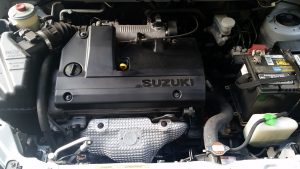

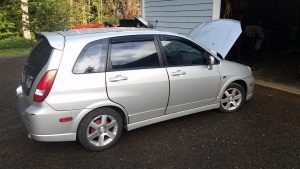


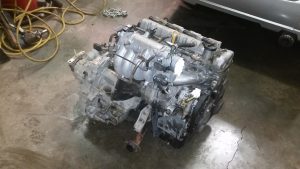

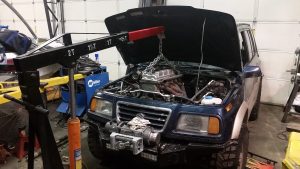
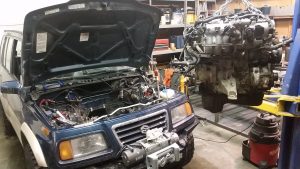
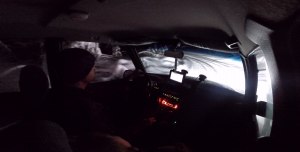


Has anybody tried or heard of putting a 2.5 v6 into a sidekick?
Okay so for the million dollar question. some my understanding when doing this swap with a little moding one can get the 2.3l ecm to work with the sport auto trans using the 2.3l emc so you can get full use of the 2.3l 155hp. after doing the slandered 2.3l swap has anyone ever put it on dino to the the power lass?
Hey, great write up. Thanks for documenting this. Quick question. I messed up taking apart my 1.8 and the 2.3 and can’t figure out how many flexplate spacers go on the crankshaft. I believe I have it figure out with one spacer then the flexplate, then the second spacer. Can anyone chime in on this if they have the auto ?
Can I use 2.3 flywheel instead of 1.8
My 1.8 is damaged
great right up! currently debating the j23 swap, do you know if this j2.3 motor can be stuffed into the 1.6 engine bay, im ok with fabricating engine mounts, I know the Sport sidekick is few inches wider, but not sure if the actual frame rails are wider than the 1.6. thankyou
Hi, I have completed the upgrade on my 1997 1.8 to the 2.3 per your article. Great improvement and thanks for the article. My question is about exhaust manifolds. My original exhaust manifold has cracks and I would like to upgrade to a header maybe. I can find 1.6 engine headers but not 1.8, are they interchangeable? Do you have other recommendations on the exhaust?
Well I’ve done it.. I completed the swap in my 1998 Sport Auto and the power is fantastic.
HOWEVER,
I’m noticing that the Air/Fuel mixture seems to be lean and the overall engine temp creeps up to 230 degrees at itle.
Even with the J23 injectors.
I’ve made sure the Thermostat is good and can tell the water pump is working fine (hot top hose, cool lower hose)
While the engine does run well I am not comfortable with the higher temps that this engine is enduring.
I’d be interested to know if others have higher temps after doing this swap??
Interesting; I have around 20,000 miles on my swap and have put it through a wide range of driving conditions. Everything from 90MPH freeway speeds, sand dunes, rock crawling, high speed desert driving, etc. I’ve never had an issue with high temps or AFR problems.
I bought a 96 sidekick with a rod knock but came with another 1.6 motor the spare motor has spark plugs in side of head and not top plus it says G16A on the head my research is there for Japan Pakistan and Indonesia sales and not U.S. it’s missing some parts but nothing major my question is can I take the missing parts from the original motor and install on the g16a motor since spark plugs are in different places didn’t know if harness would work spare motor is missing sensors so can’t tell if it’s a easy swap all sidekicks I’ve seen have the g16b motor not g16a I’ve had samurai in the past not sidekicks so it’s all new to me if the g16a won’t swap out I’ll just rebuild the original for now I’m not ready to upgrade so stock is my route you seem very knowledgeable on suzuki that’s why I’m emailing you. Any info will help thanks
Nevermind I believe the spare motor is a 8valve motor I did more searching they look like a samurai motor except its 1.6l I’ll just reboot or that came in it thanks for the motor swap info you posted great job its good to see people sharing good ideas
Good evening miles. I too have an auto sport sidekick 96. I am wondering how it connected to the transmission. What did you use or not use? Please let me
Know as I am in need of an engine replacement and would
Like to this same swap. Your info would be greatly appreciated.
Hi Danny, I just ran across your post. I assume your ’96 has the 1.8 (J18) engine. The J18 and J23 external dimensions and bolt locations are identical so the J23 is a bolt-in affair. So the flexplate (or flywheel) is the same as well as the bell housing. As noted in this article, the J18 front mounts, the exhaust manifold, the upper coolant pipe and other bits and pieces from the J18 are used and are a direct bolt-on swap. If you’re still looking for an engine, try to find a J23 if at all possible. Some Trackers and other vehicles had a J20 engine, but it’s not much better than the J18. The J23 is a big step up. My son and I put one in his ’97 Sport automatic and it was well worth it. No overheating problems until the fan bearing failed and the fan went into the radiator. It failed a second time so we converted to an electric fan from a Pontiac Vibe. This is a two speed fan. It took some trimming of the shroud and fabricated brackets but now works great. Get a dual relay from an early ’90’s Volvo and two afterrmarket fan thermostats with probes that mount in the radiator fins (upper left corner) and adjust to kick the fan on at 200 deg. low speed and 210 deg. high speed.
Hope this helps! Allan
Wow I love this type of forum, thank you Matt for this write up and job done. Nice rig you have built. yourself. Keep the videos coming!! Hi Allan Thank you for the information. I’m currently looking for a good candidate j23 for the swap. I have found a few but that all had over 250k miles. But I am definitely doing this swap, my 1.8 is good with 140k but now that I have lifted and added some 30 inch tires. It feels the added load. Plus down here in Miami 80 is the norm on the freeway. Thank you and I will post as soon as I complete the upgrade. Definitely doing the electric fan, it can only free up a few more ponies. Right!!😝
Good mooring Matt hope allis well? When you did the swap in your sons auto did you need any of the 2.3l harness?
Very nice job Matt looks like you got a nice shop well equipped. Can you tell me do all 96 sport models have the same 1.8 J motor and do all Aerio 04 to 07 have the same 2.3 J motor. Also did you purchase new intake and exhaust gaskets . Last thing do you think the auto tranny will fit and can it handle the extra power. Thanks again Matt I just bought my sport last year and soon after noticed a rod notch not sure if the prev owner added oil supplements to quiet it down but I never noticed . But look forward to the extra power and now I have a reason to proceed . I had no idea that the 2.3 was even out there so thanks for your hard work ,research ,and willingness too share ,I would be buying you some beers if I lived closer . Look forward to your reply ,take care now thanks again Harmen out of southern BC Canada Ah.
Yes, all “sport” submodels came with the same J18 1.8L engine. There may be a few very minor differences (I think coil packs might be a different design in the 98 models) but nothing that prevents the swap. And yes, all Aerio 2.3L engines are the same 04-07.
Is a swap like this feasable for a 1994 sidekick 1.6 16 valve engine?
Thanks for the incredible documentation of this effort. The writeup and video gave me the final encouragement to execute the same upgrade for my ’97 Sport here in San Diego.
I found a bargain on a nice, rebuilt 2.3 long block, and have just one question…
Did you use the hotter spark plugs that are gapped at .044″/1.1mm, or did you use the plugs spec’ed for the 1.8 at .032″/0.8mm?
I appreciate your input.
Matt,
Thank you for this information. I’m doing the same swap right now and could benefit from some additional information.
1.8 oil pan and pickup. Keep the 2.3 dipstick or use the 1.8 for showing proper oil level?
What about electric fan ?? What are you using? Single or double?
Eliminating the fan and clutch there will be room for a larger (thicker) radiator. I live in Virginia, which can see summers in the 90s . Should I consider trying to find a larger one ?
Thanks sharing the information for this swap.
What about the idle air the plug is different
Only one Question : Will Aerio 2.3 j23 Engine fit the Automatic Transmission in my 1997 Suzuki Sport . Do you happen to know if everything will will couple together to the tranny as yours did with the manual.
Yes, the bell housing and crankshaft in the j23 are identical to the 1.8, so everything should bolt up without a problem.
Are the intake and exhaust ports on the head significantly larger on the 2.3? Did you do any porting to match the 1.8 intake and exhaust to the 2.3 head?
No difference; they were an exact match.
Thanks. My 98 Sport is in line for the conversion now. I am excited to find an engine swap for the Sport that is basically a bolt in swap; no harness, no ECU, no cutting or welding, no adapters. Just got a 2004 Aerio motor for it and I am prepping it for the swap in the next few months. Even though the Aerio motor only had 51K miles it is a bit of a leap of faith that it will run as well as the 140K mile 1.8 that’s in the truck now since I don’t know how well it was cared for. Fingers crossed…
Best engine swap ever! As Matt says the key is using the Aerio injector rail, injectors, and injector harness. This transforms the Sport. I used to have to thrash the 1.8 to get around town and traffic. The 2.3 is so much more powerful that driving is now a much more relaxed experience with power to spare. If you have a Sport you have to do this swap.
No check engine light ? will pass smog tests ?
No check engine light. I do not need to pass smog in my location, however I am certain that it would pass. The ECU still shows a 1.8L displacement. The only way that an inspector would notice the swap is if he ran the casting numbers on the engine block.
Love the write up. I am doing a similar swap on my 2000 tracker 2.0l with an 07 Aerio 2.3l. Got it all swapped but having trouble getting it to fire. The cam position sensor on the two are different plugs so I used the one from the 2.0l. The cam position sensors were the same plug on yours.? It pops and backfires like a timing issue, so I think my issue is with the cam position sensor. Any help would be greatly appreciated. Thanks
Yes, the plugs matched on mine, so I left the Aerio one in place. I do know that the ECU used the cam sensor for injector and spark timing, and does not use the crank position sensor. So, I think you are on the correct track. That’s just a flat keyed slot in the cam, correct? If it isn’t offset, is it possible to get it 180 degrees off?
Yeah it’s just a flat keyed slot in the cam. I thought of the 180 out and tried both ways. I think I found my problem though. The 2.0l uses a 6 tooth reluctor on the crank where I believe the 2.3 uses a multi tooth one. I need to figure out that patter and see if I can get it to work. Might be making the jump to Megasquirt sooner than I thought.
I would be surprised if this was the problem. It is my understanding that that crank position sensor is only used for misfire detection on the J series engines. It will throw a check engine light if the crank position sensor is unplugged, but the engine will still run fine. Did you happen to count the teeth on both engines? I found the same info during my research, but discovered that both the 1.8 and 2.3 had the same number of teeth. I seems unlikely that the 2.0 would be different.
The 2.0 has a 6 tooth ring. I did the 2.3 swap from 2.0 and mine keeps stalling and intermittent no starts.
Hi, loved the info, just a few questions, I have a 97 sport JLX with the 1.8 automatic, and same as you i find it really lacks the low rpm power, I cant really find any easy performance/power/milage upgrades for it besides a cold air intake and exhaust upgrade (not sure how much those will help), with this swap you did, did you have to do any cutting or re-shaping to make it fit? Did it bolt up to the 1.8 tranny? My sidekick has about 200,000km on it, and the timing chain guides are getting worn and loud so that may be causing a bit of a power loss, just dont have alot of time or money to throw at fixing or rebuilding if i can viably do a swap and get better reliability, power, and milage.
I did have to change basically everything that bolts onto the long block; pulleys, manifolds, etc. Also the oil pan and oil pump pickup tube, dipstick, etc. But, it is basically a bolt-in swap. No adapters or custom parts were needed. I’m not sure if there are any significant differences between years, and I’ve HEARD (can’t verify that) JDM blocks are different. But, as long as you go with a domestic donor Aerio, it should all bolt in.
Hi Mat
Thank you for this article and the video.
I am about to embark on an almost exact swap with the exception of an automatic vehicle.
I purchased a 97 sidekick sport with a turned con rod bearing and rather than simply replacing the 1.8l I decided to go with the Aerio 2.3. I want to keep it as simple as possible and your video has given me the confidence to go for it.
Looking foreword to off-roading in the Arizona desert.
How has the long term reliability been? Have you had any issues related to the swap that could possibly be solved at the time of the swap?
No issues to date; I have taken this vehicle on several trips, including a 1000+ mile backcountry trip through Oregon, Idaho, Nevada, and Utah. Along that trip I pushed it with some 90+ MPH extended drives with zero problems. A few things to note: The 2.3L produces more heat than the 1.8L does; if you’re running electric fans they should be really good fans. Also, the stock clutch has a hard time holding the extra power from the 2.3L. I’m searching for a suitable upgrade right now.
Matt, Great video and inspiration for doing something with my 96 Sport sitting in my side yard. I couldn’t solve a headgasket/overheat issue. With the 1.8 ECU on the 2.3 do you think I would pass SMOG in CA.?
I can’t say with 100% certainty, but I do believe that it will pass with no problems. All of the emissions equipment is left in place, and the ECU still contains the correct VIN number, make, model, and year.
are you running the 2.3 or the 1.8 fuel rails and which ECU. I habve done a swap from 2.0 litre to 2.3 and i am running 2.0 l. fuel rail /ECU with no problems but wondering if loosing some pwer with running the 2.0l fuel rails
Hey Matt! What did you end up doing with the clutch/pressure plate on your Sidekick? You mentioned the original was not strong enough to hold the additional power. Hopefully you are still monitoring this thread!
Matt, What did you do about the clutch issues you mentioned 10/1/2016? I am getting ready to make the swap 2.3 for my 1.8 and wanted to make sure I get the clutch/flywheel sorted before everything goes in.
Great article! Thanks for posting…
Thank you for posting this information. I love my Suzuki sidekick sport, but the power is lacking. You answered all my questions about this swap. Thank you again.